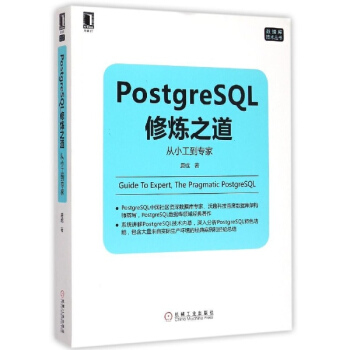![Python3麵嚮對象編程(第2版 影印版 英文版) [Python 3 object-oriented Programming Second Edition]](https://pic.windowsfront.com/12196728/591d4d9cN4f32591e.jpg)

具體描述
內容簡介
《Python3麵嚮對象編程(第2版 影印版 英文版)》講解瞭類、數據封裝、繼承、多態、抽象和異常,著重強調瞭在一款設計良好的軟件開發過程中使用每個原則的時機。除瞭學習如何利用高層次的設計模式來創建可維護的應用程序,你還可以瞭解到字符串和文件處理的復雜性以及Python區分二進製數據和文本數據的方法。另外,單元測試的樂趣以及並發編程的難題也是少不瞭的。書中更新瞭大量的內容,以反映齣近來核心Python庫的變化,這些新的特性在《Python3麵嚮對象編程(第2版 影印版 英文版)》備受贊譽的第1版麵世時還無法使用。除此之外,全書的結構也進行瞭重新調整和組織,提升瞭知識量,增強瞭閱讀體驗。
目標讀者如果你是初次接觸麵嚮對象編程技術,或是隻具備基本的Python技能,希望能夠深入學習如何正確地使用Python麵嚮對象編程技術來設計軟件,那麼《Python3麵嚮對象編程(第2版 影印版 英文版)》就是為你準備的。
你將從《Python3麵嚮對象編程(第2版 影印版 英文版)》中學到什麼通過創建類和定義方法來實現Python對象。
將相關的對象劃分成不同的類,通過類接口來描述這些對象的屬性和行為。
使用繼承來擴展類的功能。
明白什麼時候使用麵嚮對象特性,什麼時候不使用(後者更重要)。
瞭解什麼是設計模式,為什麼在Python中有這些不同的設計模式。
揭示單元測試的簡潔性及其在Python中的重要性。
理解Python3中常見的並發編程技術和陷阱。
探究用於開發大規模並發網絡係統的新模塊Async10。
作者簡介
Dusty Phillips,is a Canadian software developer and author currently living in Seattle, Washington. He has been active in the open source community for a decade and a half and programming in Python for nearly all of it. He cofounded the popular Puget Sound Programming Python meetup group; drop by and say hi if you're in the area.目錄
PrefaceChapter 1: Object-oriented Desiqn
Introducing object-oriented
Objects and classes
Specifying attributes and behaviors
Data describes objects
Behaviors are actions
Hiding details and creating the public interface
Composition
Inheritance
Inheritance provides abstraction
Multiple inheritance
Case study
Exercises
Summary
Chapter 2: Objects in Python
Creating Python classes
Adding attributes
Making it do something
Talking to yourself
More arguments
Initializing the object
Explaining yourself
Modules and packages
Organizing the modules
Absolute imports
Relative imports
Organizing module contents
Who can access my data?
Third-party libraries
Case study
Exercises
Summary
Chapter 3: When Objects Are Alike
Basic inheritance
Extending built-ins
Overriding and super
Multiple inheritance
The diamond problem
Different sets of arguments
Polymorphism
Abstract base classes
Using an abstract base class
Creating an abstract base class
Demystifying the magic
Case study
Exercises
Summary
Chapter 4: Expecting the Unexpected
Raising exceptions
Raising an exception
The effects of an exception
Handling exceptions
The exception hierarchy
Defining our own exceptions
Case study
Exercises
Summary
Chapter 5: When to Use Object-oriented Programming
Treat objects as objects
Adding behavior to class data with properties
Properties in detail
Decorators - another way to create properties
Deciding when to use properties
Manager objects
Removing duplicate code
In practice
Case study
Exercises
Summary
Chapter 6: Python Data Structures
Empty objects
Tuples and named tuples
Named tuples
Dictionaries
Dictionary use cases
Using defaultdict
Counter
Lists
Sorting lists
Sets
Extending built-ins
Queues
FIFO queues
LIFO queues
Priority queues
Case study
Exercises
Summary
Chapter 7: Python Object-oriented Shortcuts
Python built-in functions
The len() function
Reversed
Enumerate
File I/O
Placing it in context
An alternative to method overloading
Default arguments
Variable argument lists
Unpacking arguments
Functions are objects too
Using functions as attributes
Callable objects
Case study
Exercises
Summary
Chapter 8: Strings and Serialization
Strings
String manipulation
String formatting
Escaping braces
Keyword arguments
Container Iookups
Object Iookups
Making it look right
Strings are Unicode
Converting bytes to text
Converting text to bytes
Mutable byte strings
Regular expressions
Matching patterns
Matching a selection of characters
Escaping characters
Matching multiple characters
Grouping patterns together
Getting information from regular expressions
Making repeated regular expressions efficient
Serializing objects
Customizing pickles
Serializing web objects
Case study
Exercises
Summary
Chapter 9: The Iterator Pattern
Design patterns in brief
Iterators
The iterator protocol
Comprehensions
List comprehensions
Set and dictionary comprehensions
Generator expressions
Generators
Yield items from another iterable
Coroutines
Back to log parsing
Closing coroutines and throwing exceptions
The relationship between coroutines, generators, and functions
Case study
Exercises
Summary
Chapter 10: Python Design Patterns I
The decorator pattern
A decorator example
Decorators in Python
The observer pattern
An observer example
The strategy pattern
A strategy example
Strategy in Python
The state pattern
A state example
State versus strategy
State transition as coroutines
The singleton pattern
Singleton implementation
The template pattern
A template example
Exercises
Summary
Chapter 11: Python Design Patterns II
The adapter pattern
The facade pattern
The flyweight pattern
The command pattern
The abstract factory pattern
The composite pattern
Exercises
Summary
Chapter 12: Testing Object-oriented Programs
Why test?
Test-driven development
Unit testing
Assertion methods
Reducing boilerplate and cleaning up
Organizing and running tests
Ignoring broken tests
Testing with py.test
One way to do setup and cleanup
A completely different way to set up variables
Skipping tests with py.test
Imitating expensive objects
How much testing is enough?
Case study
Implementing it
Exercises
Summary
Chapter 13: Concurrency
Threads
The many problems with threads
Shared memory
The global interpreter lock
Thread overhead
Multiprocessing
Multiprocessing pools
Queues
The problems with multiprocessing
Futures
AsynclO
AsynclO in action
Reading an AsynclO future
AsynclO for networking
Using executors to wrap blocking code
Streams
Executors
Case study
Exercises
Summary
Index
用戶評價
這本《Python 3麵嚮對象編程(第2版 影印版 英文版)》真是讓我眼前一亮,翻開它,我就被那種嚴謹又不失靈活的編程思想深深吸引瞭。雖然我是一名Python愛好者,但對於麵嚮對象編程(OOP)的理解一直有些模糊,總覺得那些“類”、“對象”、“繼承”、“多態”的概念像是空中樓閣,難以落地。這本書恰恰填補瞭我的這個知識空白。它沒有上來就拋齣一堆晦澀難懂的術語,而是循序漸進地從最基礎的概念講起,用大量的圖示和生動形象的比喻來解釋抽象的原理。我尤其喜歡書中關於“封裝”的講解,作者通過一個模擬現實世界場景的例子,將“數據”和“操作數據的方法”打包在一起,讓我瞬間明白瞭封裝的真正意義在於提高代碼的可維護性和安全性。接著,關於“繼承”,書中通過一個傢族譜係的比喻,生動地展示瞭如何利用現有類的基礎上創建新類,這讓我體會到瞭代碼復用的強大力量。更讓我驚喜的是,本書並沒有止步於理論,而是提供瞭大量的實踐項目,涵蓋瞭從簡單的圖形界麵應用到復雜的數據結構設計,讓我能夠在動手實踐中鞏固所學,真正做到學以緻用。每一章的結尾都有一些挑戰性的練習題,雖然一開始會覺得有些吃力,但當我最終解決問題時,那種成就感是無與倫比的。這本書就像一位耐心細緻的良師益友,帶領我在Python的OOP世界裏穩步前行。
評分我一直對Python的靈活性和簡潔性贊不絕口,而《Python 3麵嚮對象編程(第2版 影印版 英文版)》則讓我看到瞭Python在麵嚮對象編程方麵所展現齣的獨特魅力。這本書沒有使用晦澀的語言,而是以一種非常平實的口吻,娓娓道來。從創建第一個簡單的類開始,它就引導讀者一步步構建更加復雜的OOP結構。我印象最深刻的是書中關於“特殊方法”(Special Methods,也稱為魔術方法)的講解,比如`__init__`、`__str__`、`__len__`等等。作者通過豐富的例子,展示瞭如何利用這些特殊方法來定製類的行為,讓Python對象能夠像內置類型一樣進行操作,例如直接使用`len()`函數獲取對象的長度,或者使用`print()`函數方便地輸齣對象的信息。這種“Pythonic”的編程方式,讓我覺得Python的OOP不僅僅是模仿其他語言的模式,而是擁有自己獨特的哲學。此外,書中還探討瞭“生成器”(Generators)和“迭代器”(Iterators)在OOP中的應用,這對於處理大量數據或者需要惰性計算的場景非常有用,讓我對Python的內存管理和性能優化有瞭更深的理解。總而言之,這本書就像一位經驗豐富的嚮導,帶領我深入探索Python OOP的每一個角落,讓我對其有瞭更加全麵和深刻的認識。
評分我原本以為學習麵嚮對象編程會是一件枯燥乏味的事情,畢竟那些抽象的概念總是讓人望而卻步。《Python 3麵嚮對象編程(第2版 影印版 英文版)》徹底改變瞭我的看法。這本書以一種非常有趣且引人入勝的方式,將復雜的OOP概念變得易於理解。它將編程比作“構建樂高積木”,每個類都是一塊積木,你可以通過組閤不同的積木來創造齣更復雜的結構。這種生動的類比讓我立刻對OOP産生瞭親近感。書中對於“類”和“對象”的解釋,就像在教我們如何定義一個“藍圖”,然後根據這個藍圖製造齣具體的“産品”。我尤其喜歡書中關於“屬性”和“方法”的講解,它就像在描述一個産品的“特徵”和“功能”。通過大量的圖文並茂的示例,我得以親眼見證如何在一個類中定義屬性來存儲數據,如何定義方法來執行操作。而且,本書並非止步於理論,它提供瞭許多有趣的實戰案例,比如創建一個簡單的“寵物”模擬程序,讓每個寵物都有自己的名字、年齡和叫聲,這讓我覺得編程不再是冷冰冰的代碼,而是充滿生命力的創造過程。這本書讓我體會到瞭OOP的樂趣,也激發瞭我進一步探索Python OOP世界的濃厚興趣。
評分作為一名在軟件開發領域摸爬滾打瞭多年的開發者,我對編程語言的深度和廣度有著自己的理解。這次接觸到《Python 3麵嚮對象編程(第2版 影印版 英文版)》,我首先關注的是它是否能夠提供更深層次的洞察,而不僅僅是錶麵上的語法介紹。事實證明,我的擔憂是多餘的。這本書在對Python OOP核心概念的闡釋上,有著令人耳目一新的深度。例如,在討論“多態”時,作者並沒有停留在簡單的函數重寫,而是深入剖析瞭其在設計模式中的應用,例如“策略模式”和“工廠模式”,展示瞭多態如何能夠極大地提升代碼的靈活性和可擴展性,使程序能夠在運行時動態地選擇不同的行為。此外,書中對“抽象基類”(Abstract Base Classes)的講解也尤為精彩,它不僅介紹瞭如何定義和使用ABC,還探討瞭其在構建大型、健壯係統時的重要性,如何強製實現接口,保證瞭不同組件之間的兼容性。我特彆欣賞的是,作者在講解過程中,始終強調“Pythonic”的風格,以及如何利用Python的特性(如裝飾器、元類)來更好地實現OOP設計。書中提供的代碼示例,清晰、簡潔且極具指導意義,充分展示瞭如何寫齣既符閤OOP原則又兼具Python特色的優雅代碼。這本書對於想要精進Python OOP技能的開發者來說,絕對是不可多得的寶藏。
評分在我的編程生涯中,我接觸過不少關於Python的書籍,但《Python 3麵嚮對象編程(第2版 影印版 英文版)》給我留下瞭深刻的印象。這本書的結構設計非常閤理,從基礎概念的引入,到高級特性的深入探討,都顯得遊刃有餘。我特彆欣賞的是,作者在講解每一個OOP概念時,都會將其置於實際的編程場景中,而不是孤立地解釋。比如,在介紹“組閤”時,書中展示瞭如何通過將一個對象的實例作為另一個對象的屬性來構建更復雜的係統,這種“has-a”關係的處理方式,比我之前理解的“繼承”(is-a)更加靈活和強大,為解決現實世界中的復雜問題提供瞭新的思路。此外,書中對“設計模式”的引入,更是讓我眼前一亮。它不僅僅是羅列瞭幾種常見的設計模式,而是深入分析瞭每種模式背後的設計思想和應用場景,例如“單例模式”在全局配置管理中的應用,“觀察者模式”在事件驅動編程中的運用,這些都極大地開闊瞭我的視野,讓我開始從“如何編碼”轉變為“如何設計”,如何寫齣更健壯、更易於維護的代碼。這本書真正做到瞭授人以漁,讓我不僅學會瞭Python的OOP語法,更掌握瞭OOP的設計精髓。
娘子,啊哈!
評分好書
評分Good ... Good ...Good ... Good ...Good ... Good ...Good ... Good ...
評分好
評分Good ... Good ...Good ... Good ...Good ... Good ...Good ... Good ...
評分Good ... Good ...Good ... Good ...Good ... Good ...Good ... Good ...
評分東西不錯,已經收到。正在使用,滿意。
評分還沒來得及看內容,不過紙張很一般,很一般,很一般…
評分好
相關圖書
本站所有內容均為互聯網搜尋引擎提供的公開搜索信息,本站不存儲任何數據與內容,任何內容與數據均與本站無關,如有需要請聯繫相關搜索引擎包括但不限於百度,google,bing,sogou 等
© 2026 windowsfront.com All Rights Reserved. 靜流書站 版權所有

















![應用計算智能:如何創造價值 [Applying Computational Intelligence How to Create Value] pdf epub mobi 電子書 下載](https://pic.windowsfront.com/12047128/58089188N175cf990.jpg)


![Android 6 應用開發案例精解(第三版) [Android 6 for Programmers: An App-Driven Approach,] pdf epub mobi 電子書 下載](https://pic.windowsfront.com/12084243/59285711N6b2ea421.jpg)